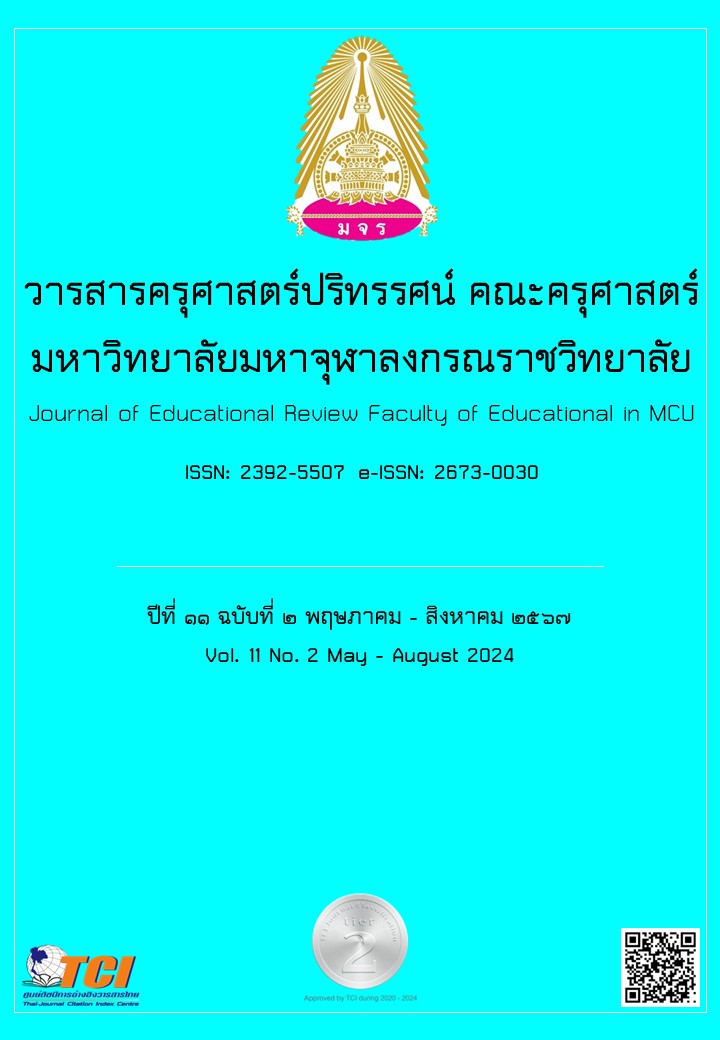แนวทางการพัฒนาการฝึกอบรมสามเณรภาคฤดูร้อนตามหลักสัทธรรม 3 ในวัดพระธรรมกาย
Main Article Content
บทคัดย่อ
บทความวิจัยนี้มีวัตถุประสงค์ 1) เพื่อศึกษาสภาพการฝึกอบรมสามเณรภาคฤดูร้อน 2) เพื่อศึกษาวิธีการพัฒนาการฝึกอบรมของสามาเณรภาคฤดูร้อนตามหลักสัทธรรม 3 และ 3) เพื่อเสนอแนวทางการพัฒนาการฝึกอบรมของสามาเณรภาคฤดูร้อนตามหลักสัทธรรม 3 ในวัดพระธรรมกาย กลุ่มตัวอย่างสามเณรในโครงการบรรพชาสามเณรภาคฤดูร้อนประจำปี 2566 จำนวน 278 รูป เก็บข้อมูลแบบสอบถามความคิดเห็นต่อสภาพการฝึกอบรมสามเณรภาคฤดูร้อน ใช้สถิติวิเคราะห์ค่าความถี่ ค่าเฉลี่ย ส่วนเบี่ยงเบนมาตรฐาน และวิเคราะห์เนื้อหา จากการสัมภาษณ์ผู้ให้ข้อมูลสำคัญจำนวน 5 รูป ผลการวิจัยพบว่า 1) สภาพการฝึกอบรมสามเณรภาคฤดูร้อน โดยภาพรวมอยู่ในระดับมาก เพราะว่า พระวิทยากรมีกิจกรรมการฝึกปฏิบัติธรรมแก่ภาคฤดูร้อนให้การศึกษาเรียนรู้วินัยเพื่อฝึกความเป็นระเบียบข้อวัตรปฏิบัติและส่งเสริมการเรียนรู้การมีจิตอาสาเพื่อสร้างองค์ความรู้แก่สามเณรที่เข้ารับการฝึกอบรมได้บำเพ็ญประโยชน์แก่สาธารณะตามลำดับความสำคัญของกิจกรรมฝึกอบรม 2) วิธีการฝึกอบรมสามเณรภาคฤดูร้อนตามหลักสัทธรรม 3 มีดังนี้ (1) ด้านกิจกรรมปฏิบัติธรรม ควรให้ความรู้ขั้นตอนก่อนการปฏิบัติกรรมฐาน (2) ด้านการฝึกวินัย ให้ความรู้เรื่องระเบียบวินัยในการนุ่มห่มให้เรียบร้อย การลุก การเดินการนั่ง การกราบ การไหว้ (3) ด้านจิตอาสา พระวิทยากรควรพาสามเณรเข้าร่วมกิจกรรมร่วมกับชุมชนเพื่อให้รู้การมีความเสียสละ (4) ด้านการบำเพ็ญประโยชน์ ควรเข้ากิจกรรมบำเพ็ญประโยชน์ในเครือข่ายวัดพระธรรมกายและร่วมกิจกรรมของชุมชนให้สามเณรที่เข้าอบรมได้เห็นคุณค่าของจิตอาสา และ 3) แนวทางการฝึกอบรมสามเณรภาคฤดูร้อนตามหลักสัทธรรม 3 มีดังนี้ ด้านที่ 1 กิจกรรมปฏิบัติธรรม (1) ปริยัตติสัทธรรม มีกิจกรรมการสวดมนต์ไหว้พระ การทำสมาธิ (2) ปฏิปัตติสัทธรรม มีการสวดมนต์ทำวัตรเช้า-เย็น และเข้าฐานนั่งทำสมาธิ เดินจงกรมเป็นกิจกรรมการเรียนรู้ (3) ปฏิเวธสัทธรรม ควรทดสอบการฝึกการสวดมนต์ทำวัตรเช้า-เย็น และการสอบอารมณ์กรรมฐาน ด้านที่ 2 การฝึกวินัย (1) ปริยัตติสัทธรรม ให้ความรู้เรื่องข้อวัตรปฏิบัติของภิกษุ-สามเณรโดยเฉพาะศีล 10 การรักษาศีล 10 และเรื่องกับสมณสารูปนุ่งห่มให้เป็นปริมณฑล การรับอาหารบิณฑบาต การฉันอาหาร (2) ปฏิปัตติสัทธรรม ควรนุ่งห่มให้เป็นปริมณฑล และข้อวัตรปฏิบัติกิจวัตรประจำวัน (3) ปฏิเวธสัทธรรม ให้สามเณรที่เข้าอบรมปฏิบัติการนุ่งห่มจีวรและรับศีล 10 ด้านที่ 3 จิตอาสา (1) ปริยัตติสัทธรรม ต้องฝึกอบรมเรียนรู้เรื่องจิตอาสาจากต้นแบบบุคคลที่มีจิตอาสาในชุมชนมาให้เรียนรู้วิธีการของจิตอาสา (2) ปริยัตติสัทธรรม ทำความสะอาดบริเวณวัด และเข้าไปมีส่วนร่วมกิจกรรมกับชุมชน (3) ปฏิเวธสัทธรรม รู้และตระหนักถึงประโยชน์ของจิตอาสา มีความรับชอบและมีความเสียสละ มีวินัยในตนเองกับการอยู่กับสังคมและอุทิศตนเพื่อประโยชน์ส่วนรวม ด้านที่ 4 การบำเพ็ญประโยชน์ (1) ปริยัตติสัทธรรม การเรียนรู้ระเบียบวินัย การฝึกอบรมการบริหารจิตและการทำงานเป็นทีม (2) ปฏิปัตติสัทธรรม รู้จักวางแผนการทำงานร่วมกัน มีความเอื้อเฟื้อเผื่อแผ่และมีอารมณ์เบิกบานแจ่มใส (3) ปฏิเวธสัทธรรม ผลจากการทำงานร่วมกันเป็นทีม ความเอื้อเฟื้อเผื่อแผ่ เป็นพลเมืองดีของสังคมและอยู่ในสังคมอยู่มีความสุข
Article Details

อนุญาตภายใต้เงื่อนไข Creative Commons Attribution-NonCommercial-NoDerivatives 4.0 International License.
ทัศนะและความคิดเห็นที่ปรากฏในบทความในวารสารฉบับนี้ถือเป็นความรับผิดชอบของผู้เขียนบทความนั้นเพียงผู้เดียว และไม่ถือเป็นทัศนะและความรับผิดชอบของกองบรรณาธิการ
กองบรรณาธิการขอสงวนสิทธิ์ในการคัดเลือกบทความลงตีพิมพ์และจะแจ้งให้เจ้าของบทความทราบหลังจากผู้ประเมินบทความตรวจอ่านบทความแล้ว
ต้นฉบับที่ได้รับการตีพิมพ์ในวารสารครุศาสตร์ปริทรรศน์ คณะครุศาสตร์ มหาวิทยาลัยมหาจุฬาลงกรณราชวิทยาลัย ถือเป็นกรรมสิทธิ์ของคณะครุศาสตร์ มหาวิทยาลัยมหาจุฬาลงกรณราชวิทยาลัย ห้ามนำข้อความทั้งหมดหรือบางส่วนไปพิมพ์ซ้ำ เว้นเสียแต่ว่าจะได้รับอนุญาตจากมหาวิทยาลัยฯ เป็นลายลักษณ์อักษร
เอกสารอ้างอิง
ชัยยุทธ ชิโนกุล. (2557). กลยุทธ์การฝึกอบรมและพัฒนาพระภิกษุสามเณรในจังหวัดชายแดนภาคใต้. ดุษฎีนิพนธ์รัฐประศาสนศาสตรดุษฎีบัณฑิต. มหาวิทยาลัยมหาจุฬาลงกรณราชวิทยาลัย.
พระครูโสภณปุญญรังสี (กฤตธัช โสภณธมฺโม). (2565). การพัฒนาโครงการฝึกอบรมธรรมทายาท: กรณีศึกษาวัดบุณยประดิษฐ์ เขตบางแค กรุงเทพมหานคร. วิทยานิพนธ์พุทธศาสตรมหาบัณฑิต. มหาวิทยาลัยมหาจุฬาลงกรณราชวิทยาลัย.
พระณัฐวุฒิ อคฺควฑฺฒโน (หนูเกื้อ). (2562). แนวทางการพัฒนาโครงการฝึกอบรมธรรมทายาทสำหรับวัดพระธรรมกายในจังหวัดปทุมธานี. วิทยานิพนธ์พุทธศาสตรมหาบัณฑิต. มหาวิทยาลัยมหาจุฬาลงกรณราชวิทยาลัย.
พระมหาจิรายุ โพธิชโย (โพธิ์ศรีทอง). (2564). แนวทางการฝึกอบรมสามเณรด้วยหลักภาวนา 4 ในจังหวัดปทุมธานี. วิทยานิพนธ์ครุศาสตรมหาบัณฑิต. มหาวิทยาลัยมหาจุฬาลงกรณราชวิทยาลัย.
ราชบัณฑิตยสถาน. (2556). พจนานุกรม ฉบับราชบัณฑิตยสถาน พ.ศ. 2554. พิมพ์ครั้งที่ 2.กรุงเทพมหานคร: นานมีบุคส์พับลิเคชั่นส์.
ลัดดาวัลย์ เพชรโรจน์, สุภมาศ อังศุโชต และอัจฉรา ชำนิประศาสน์. (2555). สถิติสำหรับการวิจัยและเทคนิคการใช้ SPSS. ฉบับปรับปรุง ครั้งที่ 2. กรุงเทพมหานคร: เจริญดีมั่นคงการพิมพ์.
วัดพระธรรมกาย. (2566). โครงการสามเณรยุวธรรมทายาท รุ่นที่ 31 (ภาคฤดูร้อน). แหล่งที่มา :https://dmc.tv/a28718 สืบค้นเมื่อ 7 พ.ค. 2566.
วัดมัชฌันติการาม. (2566). โครงการบรรพชาสามเณรภาคฤดูร้อน. แหล่งที่มา: https://watmatchan.net/summer_sammanero/ สืบต้นเมื่อ 7 พ.ค. 2566.
วินัย แดงทน. (2537). การดำเนินงานตามโครงการบรรพชาสามเณรภาคฤดูร้อน จังหวัดขอนแก่น. วิทยานิพนธ์ศึกษาศาสตรมหาบัณฑิต. มหาวิทยาลัยขอนแก่น.
ไวยากรณ์ แก้วใส. (2565). การพัฒนากระบวนการจัดกิจกรรมส่งเสริมเครือข่ายของวัดพระธรรมกาย.วิทยานิพนธ์ครุศาสตรมหาบัณฑิต. มหาวิทยาลัยมหาจุฬาลงกรณราชวิทยาลัย.
สมชาย กิจยรรยง. (2545). สูตรสำเร็จการจัดฝึกอบรม. กรุงเทพมหานคร: วิทยพัฒน์.
Keeves, Peter J. (1988). Model and Model Building: Educational Research Methodology and Measurenment : An Intermational Handbook. Oxford: Pergamon Press.
Krejcie, R. V. & Morgan, D. W. (1970). Determining sample size for research activities. Educational and Psychological Measurement. 30(3). 607–610.


